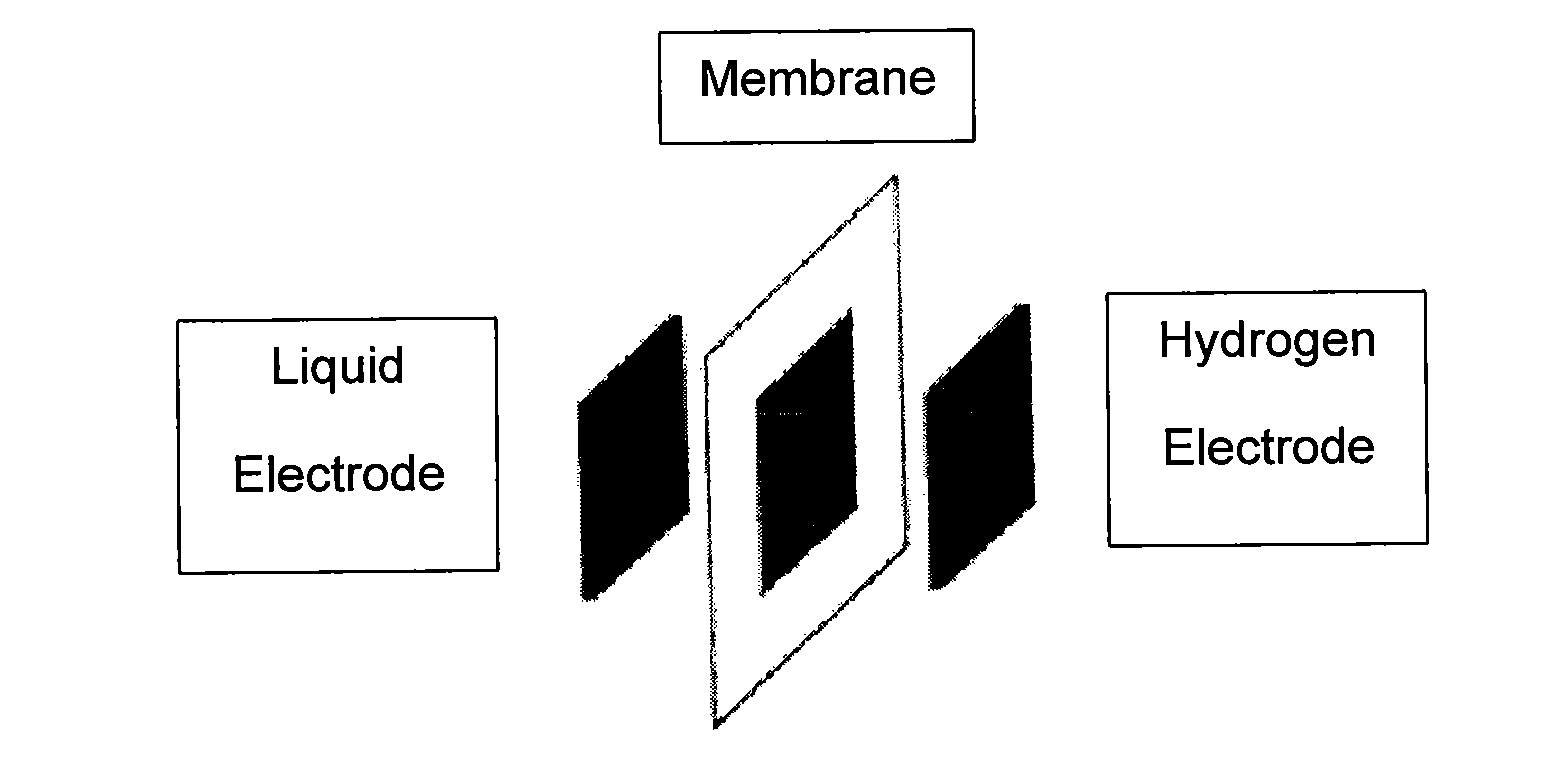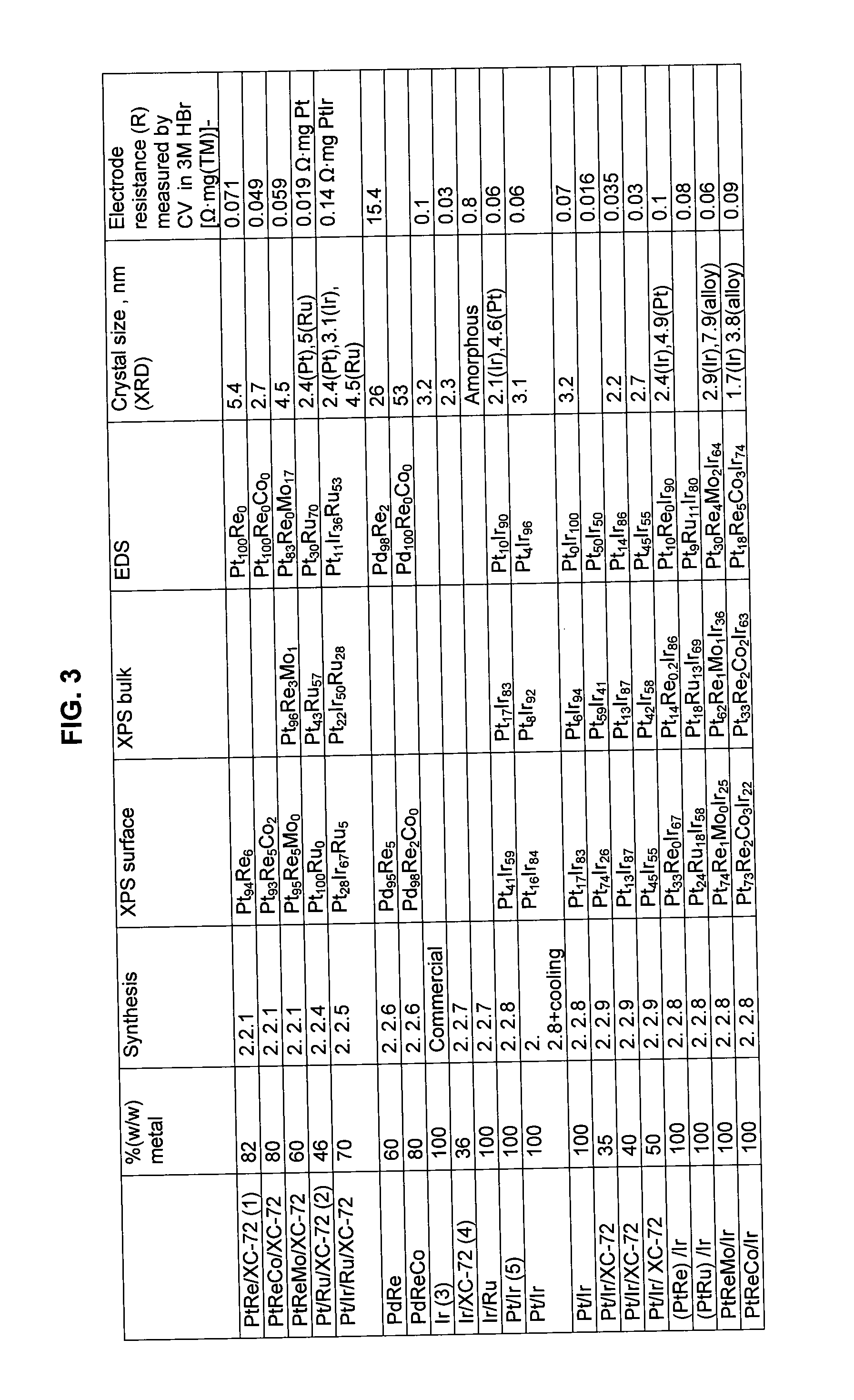Catalysts and electrodes for fuel cells
a fuel cell and catalyst technology, applied in the field of catalysts, can solve the problems of overpotential of hydrogen electrodes in regenerative fuel, membrane cannot completely prevent electrolyte crossover from one side of the cell, poisoning of hydrogen catalyst by halides, etc., and achieves the effect of high life and performance and low cos
- Summary
- Abstract
- Description
- Claims
- Application Information
AI Technical Summary
Benefits of technology
Problems solved by technology
Method used
Image
Examples
example 1
60% (w / w) Pt94Re6 / XC-72 Synthesis
[0111]0.200 g of XC-72 was added to 100 ml 0.4M HCl. 0.519 g of PtCl4 and 0.840 g of NaReO4 were added to the obtained slurry while stirring. The slurry was kept under stirring for 1 hour. 10 ml of NH4OH were added to the slurry in small portions. The pH of the solution was 11-12. 0.524 g NaBH4 were dissolved in 10 ml H2O and added to the slurry rapidly and in one portion. The slurry was kept under stirring for 1 h. The catalytic powder obtained was recovered by centrifugation, treated in 1M H2SO4 at 80° C. for 8 hours, washed with distilled water until no chloride ions could be detected and dried by evaporation.
[0112]In case of PtReCo and PtReMo the precursors that were added to the solution in synthesis 2.2.1 in FIG. 3 for Co and Mo were CoCl2.6H2O and (NH4)6Mo7O24.4H2O respectively.
example 2
30% (w / w) PtCr / XC-72
[0113]1.4 g XC-72 were suspended in 100 ml of H2O and XC-72 was finely dispersed by sonicating for 15 min. The slurry was then stirred and 1.74 ml of about 69% HNO3 were added. 0.861 grams of PTA H2PtOH6 were added to 826 ml of 4.0M HNO3 in a separate flask. PTA solution was transferred to a carbon slurry and stirred for 30 min. The beaker was heated at 1° C. / min rate up to 70° C. and this temperature was maintained for 1 h under stirring. After the heating was stopped NH3 (about 30%) was added to the slurry at a rate of 10 ml / min, until reaching a pH between 3 and 3.5 and the solution was cooled down to room temperature under stirring. 0.378 grams of Cr(NO3)3.9H2O were dissolved in 50 ml water and added to a slurry and ultrasonicated. After 30 min the pH of the slurry was adjusted to about 4.5 with 0.5M NH4OH. After 30 minutes, the heating of the solution was resumed by raising temperature to 75° C. at 1° C. / min rate. The solution was stirred and pH was controll...
example 3
30% Ru / XC-72
[0114]Ru on carbon was synthesized by polyol process in ethylene glycol. A mix of 0.5 grams 1% (w / w) Pt / XC-72 and about 1 gram RuCl3 in 900 ml ethylene glycol was stirred for 0.3 hours at 170° C. The powder was filtered; washed in H2O and acetone and vacuum dried at 100° C. The powder was acid treated in 0.5 M H2SO4 at 80° C. for 8 hours, and washed in H2O.
PUM
| Property | Measurement | Unit |
|---|---|---|
| grain sizes | aaaaa | aaaaa |
| porosity | aaaaa | aaaaa |
| porosity | aaaaa | aaaaa |
Abstract
Description
Claims
Application Information
 Login to View More
Login to View More - R&D
- Intellectual Property
- Life Sciences
- Materials
- Tech Scout
- Unparalleled Data Quality
- Higher Quality Content
- 60% Fewer Hallucinations
Browse by: Latest US Patents, China's latest patents, Technical Efficacy Thesaurus, Application Domain, Technology Topic, Popular Technical Reports.
© 2025 PatSnap. All rights reserved.Legal|Privacy policy|Modern Slavery Act Transparency Statement|Sitemap|About US| Contact US: help@patsnap.com



